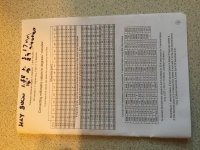Begs the question--to me, at least--with the modern specs for zero toe and zero degrees camber, what is appropriate for an older car like our Healeys? My dad explained to me the reason for a degree or two positive camber was it made the track of the wheels like rolling an ice cream cone on its side; i.e. the cone would curve in the direction its tip pointed. With the wheels trying to turn outwards while rolling, this would pull slack out of the linkage, resulting in more-or-less zero toe-in as you drove. Modern cars, most with rack-and-pinion steering and more accurate McPherson or other coilover suspension, can have zero, or even slightly negative camber--for turn-in, I presume--and no toe-in. I know some run zero or negative camber; I wonder what effect that has on toe when rolling?

 Hi Guest!
Hi Guest!

 smilie in place of the real @
smilie in place of the real @
 Pretty Please - add it to our Events forum(s) and add to the calendar! >>
Pretty Please - add it to our Events forum(s) and add to the calendar! >> 


